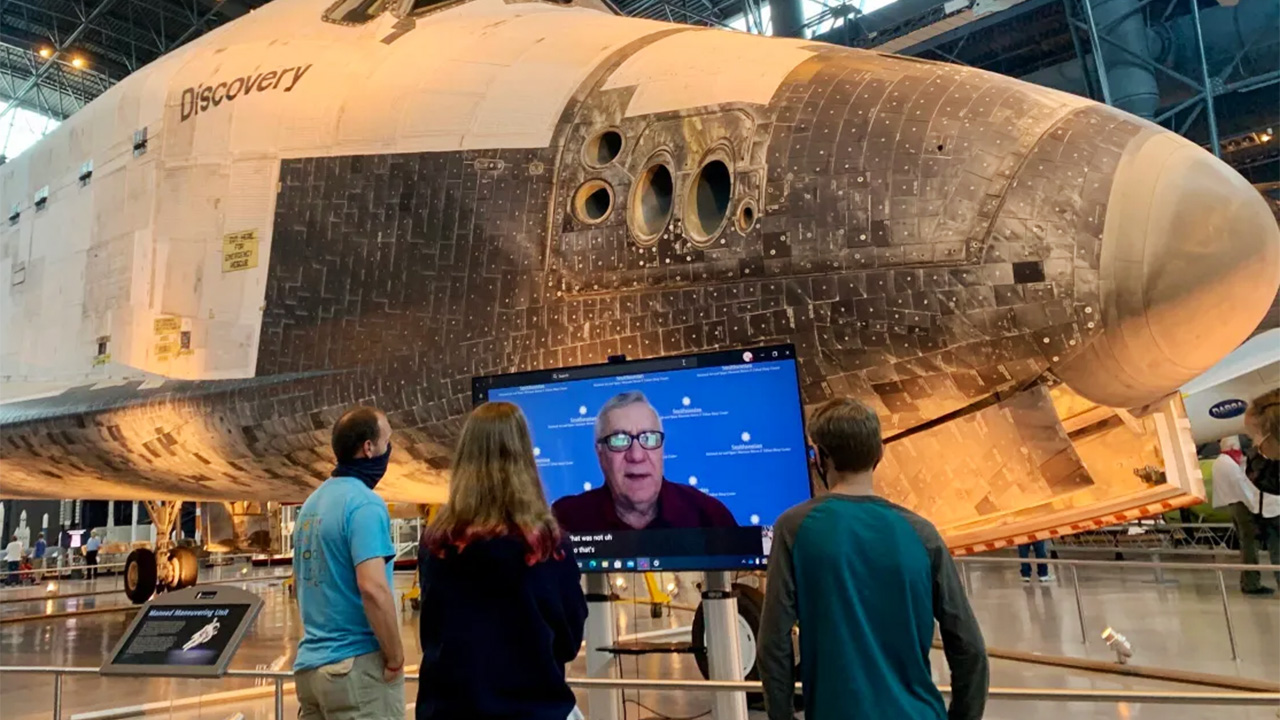Since July 2020, the Steven F. Udvar-Hazy Center, an adjunct of the Smithsonian National Air and Space Museum (NASM), has dispatched virtual docents to guide and interact with visitors at its welcome desk and exhibitions. These virtual volunteers appear on monitors at stations scattered throughout the museum in Chantilly, Virginia, offering live commentary and conversation, and serving as an antidote to COVID-related social distancing measures.
“The instant we closed the museum last year, we started thinking about reopening,” Richard Weld, the museum’s Visitor Services Supervisor, tells Jing Culture and Commerce. “The first question we had was: What will that look like for volunteers?” The center launched its virtual docent program as an experiment, but just a month in, these virtual guides were installed as part of its normal operations.

Each virtual docent station at the Steven F. Udvar-Hazy Center features a monitor, mounted with a webcam that facilitates real-time interactions with visitors on the museum floor. Image: National Air and Space Museum
The remote nature of the program ensures safe interactions within the galleries, while enabling the museum to greatly expand its volunteer recruitment base. Because virtual docents sign in remotely via Microsoft Teams, volunteers could be located in any part of the world, unbound by geography.
Today, the Udvar-Hazy Center isn’t the only institution with a virtual volunteer initiative — the San Diego Museum of Art, the Metropolitan Museum of Art, and the Hudson River Museum are just some venues that offer docent-led virtual tours. NASM, however, was one of the first to institute such a program. “The Steven F. Udvar-Hazy Center was one of the first Smithsonian museums to open last year,” Weld says. “We had one of the first staff openings, and the next day, other Smithsonian museums started asking, ‘How do we do this?'”
Below, Weld tells Jing Culture & Commerce exactly how in a conversation about the center’s virtual volunteer program.
Can you walk us through how a virtual docent works?
The first day we did this, we split an eight-hour day between three people. By the end of the day, all of them were exhausted. [Being a virtual docent] is much more dynamic than regular volunteering. You have to be focused on that screen the entire time, and Zoom meetings can wear you out. We’ve experimented with 60 to 90-minute shifts, landing on 90 minutes. We tell volunteers that there are multiple monitors [available in the museum], but don’t do back-to-back shifts. Give yourself a break. Some people will do up to three hours a day, but not back to back.
Are these virtual volunteers often the same ones the center worked with pre-pandemic?
Yes, it’s just museum volunteers that we had previously. Now, as we go forward, we’re thinking we’re going to keep the a lot of virtual volunteer stations, [though] not necessarily as many as we had at our peak. But that means we might start recruiting new volunteers for specifically for that task. Our total volunteer core is over 1,000 at the museum. For my department, we’ve got about 650 of those. Of those, a little over 200 said they were interested in being virtual volunteers on these monitors — that’s including both the virtual welcome desk volunteers and the virtual docents.

The Udvar-Hazy Center was one of the first Smithsonian institutions to reopen in May 2020 with health and safety precautions from timed-entry passes to mask requirements. Image: The Space Shuttle Discovery at the Steven F. Udvar-Hazy Center, National Air and Space Museum
What do visitor interactions look like?
What we have is a 65-inch television screen attached to a computer and webcam, with one webcam pointing towards the museum floor. As people walk by the volunteers can say, “Hi, can I help you?” Oftentimes, visitors, think they’re a recording, so our docents and volunteers have to say things like “That’s a great red shirt you’re wearing!”
The visitors can walk up and say, “Hey, I have a question: your monitor’s here in front of the Space Shuttle Discovery, can you tell me about that?” Or “I want to know more about that airplane over there.” And we asked the volunteers to keep it short, about five minutes per family. People will be lining up to wait their turn, so they have to keep the line moving, even though they’re 20 or 30 miles away.
Does the center offer multilingual virtual docents as well?
That is based on our volunteer signup. If the docent speaks a non-English language, then yes. Unfortunately, we have a limited number of monitors, and none of them are specifically geared for any language. We do have quite a few multilingual docents and they’ve been having a great time helping visitors for whom English is not their first language.
How does the museum plan on continuing the program post-pandemic?
We’re going to be expanding our options later this year and have virtual tours for people who will not be in the museum. We also intend to bring back in-person docents based on safety parameters. That personal touch is important to us.



